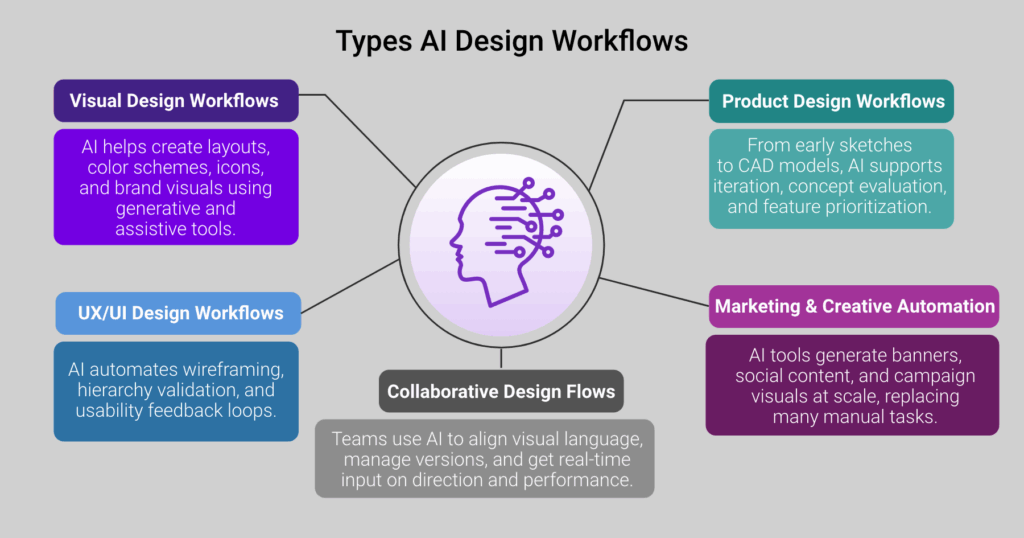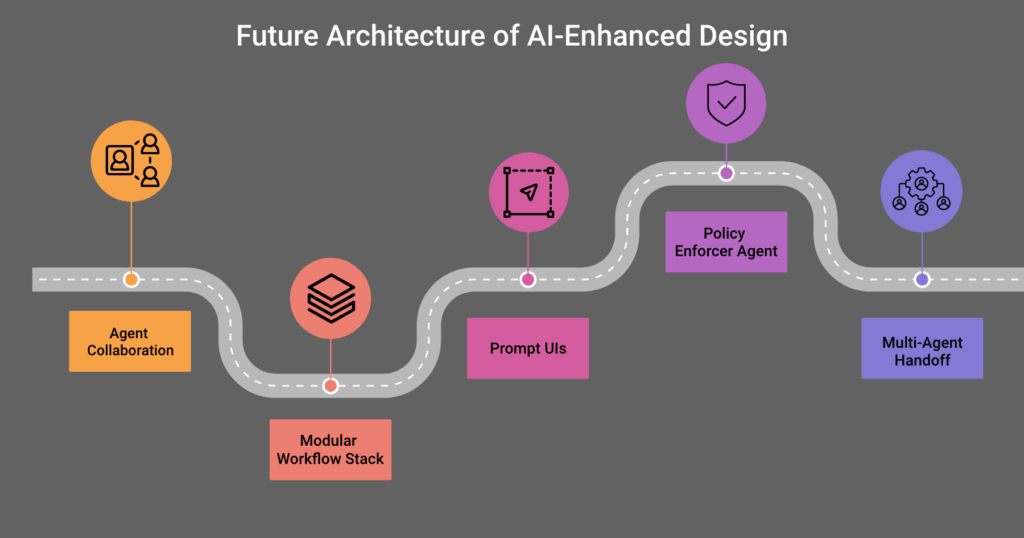AI design workflow leverages intelligent automation to improve output and accuracy.
An AI design workflow refers to a series of creative or product development steps enhanced or automated by AI-powered tools. These workflows streamline repetitive tasks, improve output quality, and enable design teams to collaborate more efficiently by integrating AI into every stage of the design process.
Detailed Definition & Explanation
An AI design workflow integrates artificial intelligence into creative and product design processes, automating tasks that were traditionally manual and time-intensive. From ideation to prototyping, these workflows apply AI driven systems including image generation, natural language interfaces, and predictive analytics to enhance design speed, precision, and collaboration.
AI-enhanced design processes use a combination of pretrained or fine-tuned AI models, embedded logic, and adaptive interfaces to assist with specific design tasks. These may include layout suggestions, typography adjustments, generative color palettes, real-time user testing insights, and even code scaffolding for front-end experiences. As a result, teams can shift from static, linear processes to agile, iterative ones, those powered by data and pattern recognition rather than trial and error.
The value of integrating AI into your design lies not just in replacing traditional methods, but in expanding what’s creatively possible. AI tools now support enhanced creative workflows across marketing, UX, industrial design, and product development. By automating design workflows, organizations reduce bottlenecks, shorten review cycles, and ensure consistency across output, particularly when collaborating across distributed teams.
Here’s how it works:
- Input Processing: Users submit prompts, sketches, or parameters via design tools or AI interfaces.
- AI Interpretation: The system parses inputs using machine learning or NLP-based models.
- Design Generation: Based on context, the AI generates visual options, wireframes, or prototypes.
- Iteration Loop: Users refine results with AI assistance via conversational UIs or fine-tuned prompts.
- Export & Integration: Final assets are handed off to dev, CMS, or production pipelines for execution.

Why It Matters
- Streamlines repetitive or manual tasks in the design process
AI design workflows automate common bottlenecks like formatting, layout corrections, or asset resizing, saving time and reducing human error. In consumer product design, this enables faster go-to-market timelines. In e-commerce, creative teams use AI powered tools to rapidly generate campaign variations without manual replication.
- Enhances creative output without replacing human intuition
By integrating AI into design, teams can explore more variations, catch inconsistencies, and generate higher-quality outputs. In higher education, marketing and enrollment teams are using AI in design to generate branded visuals and student communications at scale, while academic departments begin integrating AI-enhanced workflows for advising, grading, and decision support.
- Improves cross-functional collaboration in complex design workflows
AI tools serve as intermediaries between design, dev, and marketing, translating intent into executable formats. In financial services, compliance constraints can be built into design automation tools to ensure regulatory alignment. In insurance, product teams use AI assistance to maintain consistency across digital experiences.
- Reduces dependency on traditional tools and accelerates iteration
Creative workflow automation reduces time spent toggling between disconnected systems. In CPS industries, teams replace traditional methods with integrated AI solutions that connect strategy, design, and delivery, enabling faster feedback loops and consistent brand messaging.
- Enables data-driven, scalable design decisions
With machine learning at its core, AI design workflows analyze what works—whether it’s A/B test results, scroll maps, or conversion rates—to make better decisions faster. In e-commerce, this results in landing pages optimized through continuous learning. In education, AI tools help design interfaces that improve engagement metrics for online learners.
Adoption Trends and Real-World Examples
The role of AI in design is expanding beyond assistive plugins to full-fledged creative platforms that enhance how product and content teams work. According to Adobe’s 2024 Creative Trends report, 83% of creative professionals say they are actively integrating AI tools into workflows, while 66% use GenAI tools for improved creative output. According to Virtasant, AI in product development has helped companies cut development times by up to 50%, underscoring the productivity benefits of AI-driven design systems.
This momentum forms a strong foundation that’s already visible across sectors:
Canva AI: Canva’s Magic Studio integrates generative AI into its design tools, enabling users to generate layouts, visuals, and branded assets at scale. It allows marketing and design teams to rapidly explore concepts and adapt templates for different audiences, reducing repetitive design tasks and streamlining creative production.
Uizard: Uizard is a UI-focused design platform that uses AI to turn sketches or plain-text prompts into wireframes and functional mockups. It empowers non-designers and product managers to contribute to interface design, accelerating early-phase collaboration between product and engineering.
Figma AI: Figma’s upcoming AI features enable designers to automate layout generation, apply design system rules, and surface recommendations during prototyping. These capabilities help teams maintain visual consistency and reduce redundant styling work, particularly in larger enterprise design systems.
FD Ryze: FD Ryze includes AI-powered design agents that support creative workflow automation across product development, e-commerce design, and compliance-oriented content generation. Its agents work alongside marketing, legal, and UX teams to generate consistent, branded assets and interface mockups, reducing time spent on manual approvals while improving quality.
What Lies Ahead

- Design agents will become embedded co-creators across product teams
AI will shift from assistive role to collaborative partner in creative processes, proposing layouts, validating design rules, and surfacing accessibility concerns. Teams will need frameworks for prompt standardization, override governance, and ethical design parameters.
- Enterprise-grade design workflows will integrate AI at every layer
From strategy to execution, AI will be embedded in planning, concept testing, production, and analytics. Organizations must architect design stacks that can handle modular agent handoffs, version control, and integrated performance feedback.
- No-code and prompt-based design interfaces will redefine creative tools
Generative UI platforms will reduce dependence on traditional design tools, favoring natural language interaction and modular templates. Creative professionals will need training in prompt engineering and rapid validation techniques.
- AI will unify visual governance across global teams
Design consistency will be enforced through policy-driven AI agents that adapt brand guidelines across regions, products, and teams. To prepare, enterprises must codify their visual systems into machine-readable formats and deploy design agents that can enforce alignment.
- Cross-functional collaboration will be orchestrated by multi-agent systems
AI design workflows will integrate with dev, legal, marketing, and product workflows through shared orchestration layers. Expect to see design reviews, compliance checks, and testing insights handled via multi-agent coordination. Teams should invest in connected platforms that allow these agents to speak the same language.
Related Terms
- Creative Workflow Automation
- Automated Design Systems
- AI Assistance in Creative Teams
- Prompt-Based UI Design
- No-Code AI Tools
- Intelligent Design Orchestration
- AI Agents in Collaboration
- Enhanced Creative Workflows
